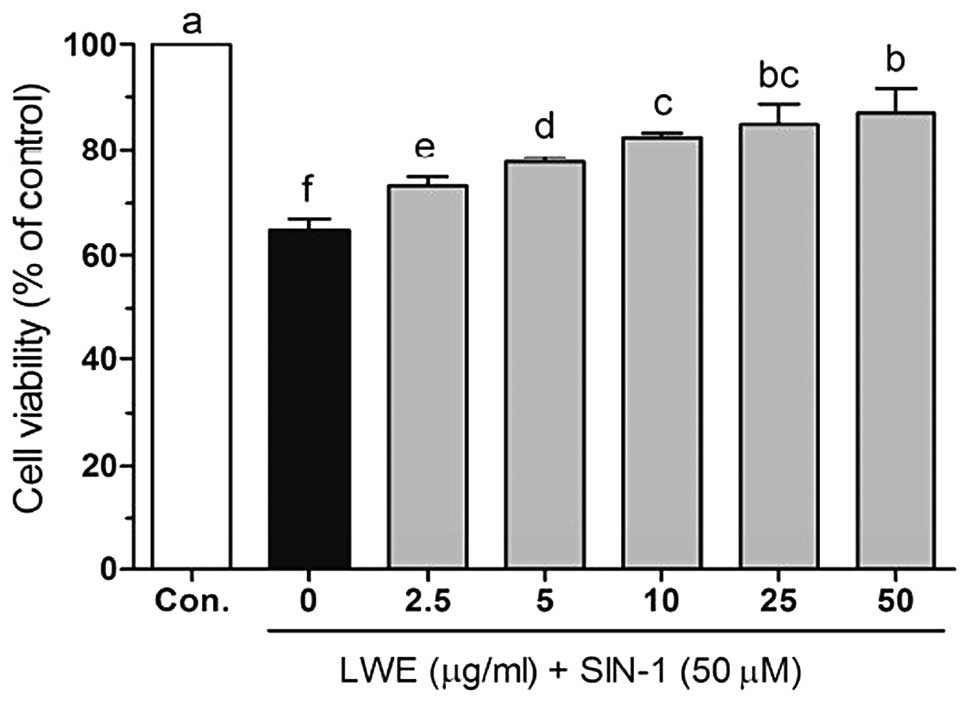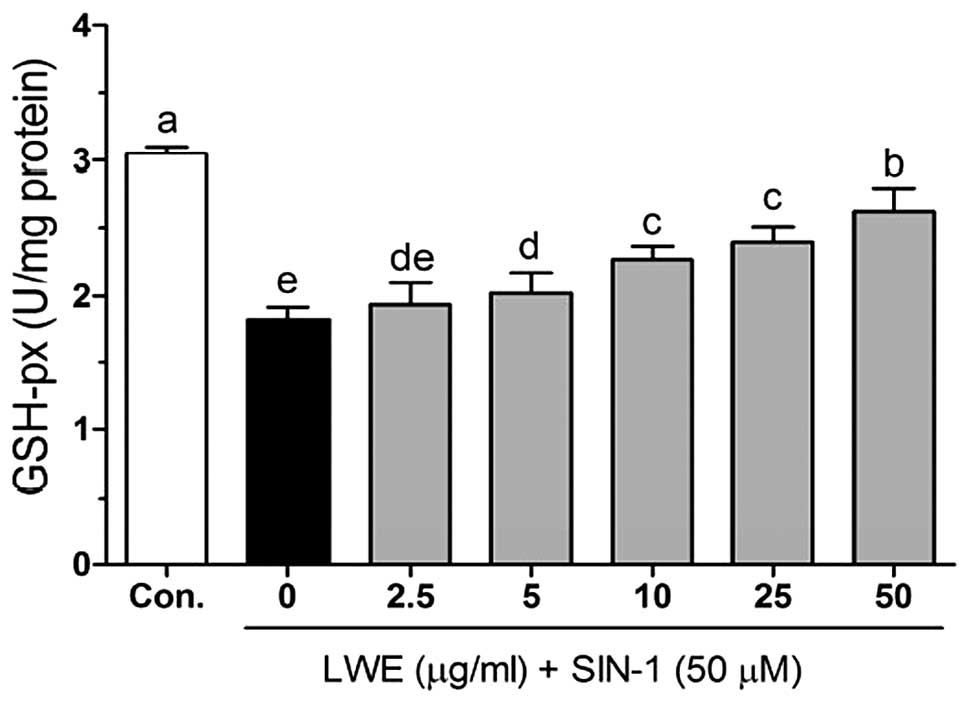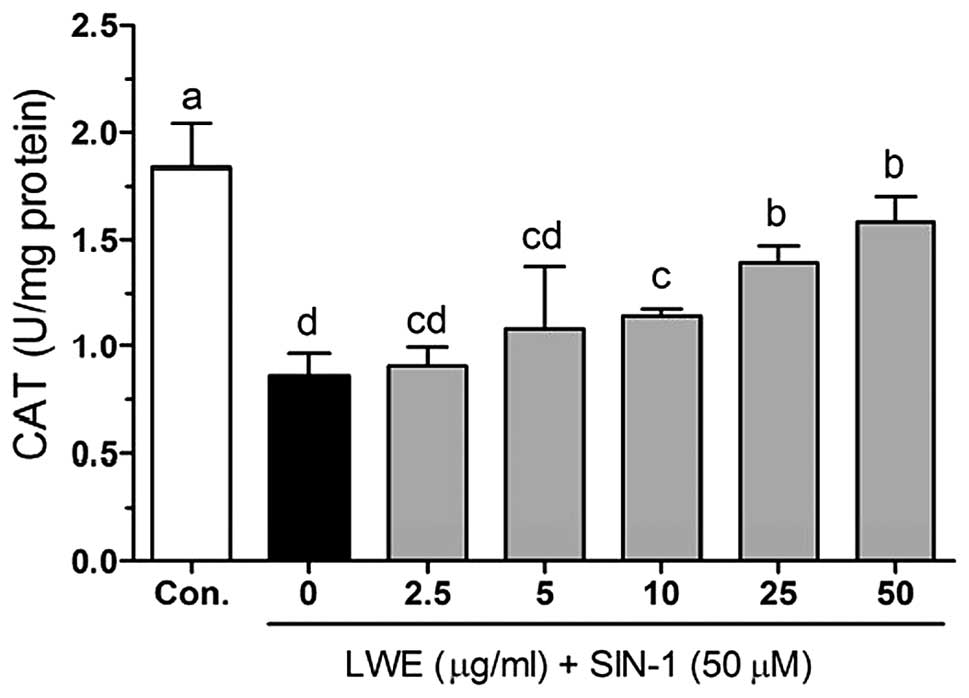|
1
|
Halliwell B: Reactive species and
antioxidants. Redox biology is a fundamental theme of aerobic life.
Plant Physiol. 141:312–22. 2006. View Article : Google Scholar : PubMed/NCBI
|
|
2
|
Evans JL, Goldfine ID, Maddux BA and
Grodsky GM: Are oxidative stress-activated signaling pathways
mediators of insulin resistance and beta-cell dysfunction?
Diabetes. 52:1–8. 2003. View Article : Google Scholar : PubMed/NCBI
|
|
3
|
Rahimi R, Nikfar S, Larijani B and
Abdollahi M: A review on the role of antioxidants in the management
of diabetes and its complications. Biomed Pharmacother. 59:365–373.
2005. View Article : Google Scholar : PubMed/NCBI
|
|
4
|
Robertson RP and Harmon JS: Diabetes,
glucose toxicity, and oxidative stress: a case of double jeopardy
for the pancreatic islet beta cell. Free Radic Biol Med.
41:177–184. 2006. View Article : Google Scholar : PubMed/NCBI
|
|
5
|
Bell DS: Do sulfonylurea drugs increase
the risk of cardiac events? CMAJ. 174:185–186. 2006. View Article : Google Scholar : PubMed/NCBI
|
|
6
|
Home PD, Pocock SJ, Beck-Nielsen H, Gomis
R, Hanefeld M, Jones NP, Komajda M and McMurray JJ; RECORD Study
Group. Rosiglitazone evaluated for cardiovascular outcomes - an
interim analysis. N Engl J Med. 357:28–38. 2007. View Article : Google Scholar : PubMed/NCBI
|
|
7
|
Psaty BM and Furberg CD: The record on
rosiglitazone and the risk of myocardial infarction. N Engl J Med.
357:67–69. 2007. View Article : Google Scholar : PubMed/NCBI
|
|
8
|
Nathan DM: Rosiglitazone and
cardiotoxicity - weighing the evidence. N Engl J Med. 357:64–66.
2007. View Article : Google Scholar : PubMed/NCBI
|
|
9
|
Bailey CJ and Day C: Traditional plant
medicines as treatments for diabetes. Diabetes Care. 12:553–564.
1989. View Article : Google Scholar : PubMed/NCBI
|
|
10
|
Garcia F: Distribution and deterioration
of insulin-like principle in Lagerstroemia speciosa
(banaba). Acta Med Philippina. 3:99–104. 1941.
|
|
11
|
Klein G, Kim J, Himmeldirk K, Cao Y and
Chen X: Antidiabetes and anti-obesity activity of Lagerstroemia
speciosa. Evid Based Complement Alternat Med. 4:401–407. 2007.
View Article : Google Scholar
|
|
12
|
Mishra Y, Khan MSY, Zafar R and Agarwal
SS: Hypoglycemic activity of leaves of Lagerstroemia
speciosa (L) Pers. Indian J Pharmacol. 22:174–176. 1990.
|
|
13
|
Priya TT, Sabu MC and Jolly CI: Free
radical scavenging and anti-inflammatory properties of
Lagerstroemia speciosa (L). Inflammopharmacology.
16:182–187. 2008. View Article : Google Scholar : PubMed/NCBI
|
|
14
|
Khan MT, Lampronti I, Martello D, Bianchi
N, Jabbar S, Choudhuri MS, Datta BK and Gambari R: Identification
of pyrogallol as an antiproliferative compound present in extracts
from the medicinal plant Emblica officinalis: effects on in
vitro cell growth of human tumor cell lines. Int J Oncol.
21:187–192. 2002.PubMed/NCBI
|
|
15
|
Suzuki Y, Unno T, Ushitani M, Hayashi K
and Kakuda T: Antiobesity activity of extracts from
Lagerstroemia speciosa L. leaves on female KK-Ay mice. J
Nutr Sci Vitaminol (Tokyo). 45:791–795. 1999. View Article : Google Scholar
|
|
16
|
Kakuda T, Sakane I, Takihara T, Ozaki Y,
Takeuchi H and Kuroyanagi M: Hypoglycemic effect of extracts from
Lagerstroemia speciosa L. leaves in genetically diabetic
KK-AY mice. Biosci Biotechnol Biochem. 60:204–208. 1996.
|
|
17
|
Liu F, Kim J, Li Y, Liu X, Li J and Chen
X: An extract of Lagerstroemia speciosa L. has insulin-like
glucose uptake-stimulatory and adipocyte differentiation-inhibitory
activities in 3T3-L1 cells. J Nutr. 131:2242–2247. 2001.PubMed/NCBI
|
|
18
|
Liu X, Kim JK, Li Y, Li J, Liu F and Chen
X: Tannic acid stimulates glucose transport and inhibits adipocyte
differentiation in 3T3-L1 cells. J Nutr. 135:165–171.
2005.PubMed/NCBI
|
|
19
|
Liu J, Sun H, Duan W, Mu D and Zhang L:
Maslinic acid reduces blood glucose in KK-Ay mice. Biol Pharm Bull.
30:2075–2078. 2007. View Article : Google Scholar : PubMed/NCBI
|
|
20
|
Fraga CG, Leibovitz BE and Tappel AL:
Lipid peroxidation measured as thiobarbituric acid-reactive
substances in tissue slices: characterization and comparison with
homogenates and microsomes. Free Radic Biol Med. 4:155–161. 1988.
View Article : Google Scholar
|
|
21
|
Nelson DP and Kiesow LA: Enthalpy of
decomposition of hydrogen peroxide by catalase at 25 degrees C
(with molar extinction coefficients of H2O2
solutions in the UV). Anal Biochem. 49:474–478. 1972. View Article : Google Scholar : PubMed/NCBI
|
|
22
|
Marklund S and Marklund G: Involvement of
the superoxide anion radical in the autoxidation of pyrogallol and
a convenient assay for superoxide dismutase. Eur J Biochem.
47:469–474. 1974. View Article : Google Scholar : PubMed/NCBI
|
|
23
|
Hafeman DG, Sunde RA and Hoekstra WG:
Effect of dietary selenium on erythrocyte and liver glutathione
peroxidase in the rat. J Nutr. 104:580–587. 1974.PubMed/NCBI
|
|
24
|
Robertson RP, Harmon J, Tran PO, Tanaka Y
and Takahashi H: Glucose toxicity in beta-cells: type 2 diabetes,
good radicals gone bad, and the glutathione connection. Diabetes.
52:581–587. 2003. View Article : Google Scholar : PubMed/NCBI
|
|
25
|
Cheng Q, Law PK, de Gasparo M and Leung
PS: Combination of the dipeptidyl peptidase IV inhibitor LAF237
[(S)-1-[(3-hydroxy-1-adamantyl)ammo]acetyl-2-cyanopyrrolidine] with
the angiotensin II type 1 receptor antagonist valsartan
[N-(1-oxopentyl)-N-[[2′-(1H-tetrazol-5-yl)-[1,1′-biphenyl]-4-yl]methyl]-L-valine]
enhances pancreatic islet morphology and function in a mouse model
of type 2 diabetes. J Pharmacol Exp Ther. 327:683–691. 2008.
|
|
26
|
Lenzen S: Oxidative stress: the vulnerable
beta-cell. Biochem Soc Trans. 36:343–347. 2008. View Article : Google Scholar : PubMed/NCBI
|
|
27
|
Zhang H, Ollinger K and Brunk U:
Insulinoma cells in culture show pronounced sensitivity to
alloxan-induced oxidative stress. Diabetologia. 38:635–641. 1995.
View Article : Google Scholar : PubMed/NCBI
|
|
28
|
Moriscot C, Pattou F, Kerr-Conte J,
Richard MJ, Lemarchand P and Benhamou PY: Contribution of
adenoviral-mediated superoxide dismutase gene transfer to the
reduction in nitric oxide-induced cytotoxicity on human islets and
INS-1 insulin-secreting cells. Diabetologia. 43:625–631. 2000.
View Article : Google Scholar
|
|
29
|
Kubisch HM, Wang J, Bray TM and Phillips
JP: Targeted overexpression of Cu/Zn superoxide dismutase protects
pancreatic beta-cells against oxidative stress. Diabetes.
46:1563–1566. 1997. View Article : Google Scholar : PubMed/NCBI
|
|
30
|
Kubisch HM, Wang J, Luche R, Carlson E,
Bray TM, Epstein CJ and Phillips JP: Transgenic copper/zinc
superoxide dismutase modulates susceptibility to type I diabetes.
Proc Natl Acad Sci USA. 91:9956–9959. 1994. View Article : Google Scholar : PubMed/NCBI
|
|
31
|
Xu B, Moritz JT and Epstein PN:
Overexpression of catalase provides partial protection to
transgenic mouse beta cells. Free Radic Biol Med. 27:830–837. 1999.
View Article : Google Scholar : PubMed/NCBI
|
|
32
|
Amstad P, Moret R and Cerutti P:
Glutathione peroxidase compensates for the hypersensitivity of
Cu,Zn-superoxide dismutase overproducers to oxidant stress. J Biol
Chem. 269:1606–1609. 1994.PubMed/NCBI
|
|
33
|
Lortz S and Tiedge M: Sequential
inactivation of reactive oxygen species by combined overexpression
of SOD isoforms and catalase in insulin-producing cells. Free Radic
Biol Med. 34:683–688. 2003. View Article : Google Scholar : PubMed/NCBI
|
|
34
|
Lepore DA, Shinkel TA, Fisicaro N, Mysore
TB, Johnson LE, d’Apice AJ and Cowan PJ: Enhanced expression of
glutathione peroxidase protects islet beta cells from
hypoxia-reoxygenation. Xenotransplantation. 11:53–59. 2004.
View Article : Google Scholar : PubMed/NCBI
|
|
35
|
Mysore TB, Shinkel TA, Collins J, Salvaris
EJ, Fisicaro N, Murray-Segal LJ, Johnson LE, Lepore DA, Walters SN,
Stokes R, Chandra AP, O’Connell PJ, d’Apice AJ and Cowan PJ:
Overexpression of glutathione peroxidase with two isoforms of
superoxide dismutase protects mouse islets from oxidative injury
and improves islet graft function. Diabetes. 54:2109–2116. 2005.
View Article : Google Scholar : PubMed/NCBI
|


















